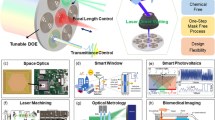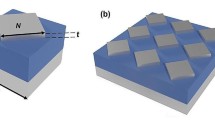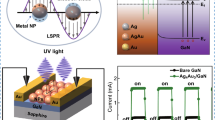Abstract
Light polarization could provide critical visual information (e.g., surface roughness, geometry, or orientation) of the imaged objects beyond prevailing signals of intensity and wavelength. The polarization imaging technology thus has a large potential in broad fields such as object detection. However, intricate polarization coding is often required in these fields, and the existing complicated lensed system and polarizers have limited the miniaturization capabilities of the integrated imaging sensor. In this study, we demonstrate the utilization of two-dimensional (2D) in-plane anisotropic α-GeSe semiconductor to realize the polarizer-free polarization-sensitive visible/near-infrared (VIS-NIR) photodetector/imager. As the key part of the sensor system, this prototype Au/GeSe/Au photodetector exhibits impressive performances in terms of high sensitivity, broad spectral response, and fast-speed operation (∼103 AW−1 400–1050 nm, and 22.7/49.5 µs). Further, this device demonstrates unique polarization sensitivity in the spectral range of 690–1050 nm and broadband absorption of light polarized preferentially in the γ-direction, as predicted by the analysis of optical transition behavior in α-GeSe. Then we have successfully incorporated the 2D GeSe device into an imaging system for the polarization imaging and captured the polarization information of the radiant target with a high contrast ratio of 3.45 at 808 nm (NIR band). This proposed imager reveals the ability to sense dual-band polarization signals in the scene without polarizers and paves the way for polarimetric imaging sensor arrays for advanced applications.
摘要
偏振是光的一个重要信息, 偏振探测可以把信息量从三维 (光强、光谱和空间)扩充到七维(光强、光谱、空间、偏振度、光 偏振等), 为成像物体提供关键的视觉信息(如表面粗糙度、几何形 状或方向), 因此偏振成像技术在目标检测等领域有着巨大的潜力. 然而这些领域往往需要复杂的偏振编码, 现有的复杂透镜系统和 偏振器限制了集成成像传感器的小型化能力. 本文通过二维各向 异性α-GeSe半导体, 成功实现了无偏振器的偏振敏感可见-近红外 光电探测器/成像仪. 作为传感器系统的关键部件, 该原型Au/GeSe/Au光电探测器具有灵敏度高、光谱响应宽、响应速度快 (~103 A W−1, 400–1050 nm, 22.7/49.5 μs)等优点. 此外, 该器件在 690–1050 nm光谱范围内表现出独特的偏振灵敏度, 并且对沿y方 向的偏振光吸收最强, 这一点通过分析α-GeSe的光跃迁行为也得 到了证实. 最后, 将2D-GeSe器件应用到成像系统中进行偏振成像, 在808 nm近红外波段处, 在不同的偏振方向上, 辐射目标的对比度 为3.45. 这种成像仪在没有偏振器的情况下, 能够在场景中感知双 频偏振信号, 为偏振成像传感器阵列的广泛应用奠定了基础.
Similar content being viewed by others
References
Rubin NA, D’Aversa G, Chevalier P, et al. Matrix Fourier optics enables a compact full-Stokes polarization camera. Science, 2019, 365: eaax1839
Empedocles SA, Neuhauser R, Bawendi MG. Three-dimensional orientation measurements of symmetric single chromophores using polarization microscopy. Nature, 1999, 399: 126–130
Li Q, Li ZF, Li N, et al. High-polarization-discriminating infrared detection using a single quantum well sandwiched in plasmonic micro-cavity. Sci Rep, 2014, 4: 6332
Niu S, Joe G, Zhao H, et al. Giant optical anisotropy in a quasione-dimensional crystal. Nat Photon, 2018, 12: 392–396
Zheng F, Tao X, Yang M, et al. Design of efficient superconducting nanowire single photon detectors with high polarization sensitivity for polarimetric imaging. J Opt Soc Am B, 2016, 33: 2256–2264
Abrahamsson S, McQuilken M, Mehta SB, et al. Multifocus polarization microscope (MF-PolScope) for 3D polarization imaging of up to 25 focal planes simultaneously. Opt Express, 2015, 23: 7734–7754
Zhao Y, Peng Q, Yi C, et al. Multiband polarization imaging. J Sens, 2016, 2016: 5985673
Tyo JS, Goldstein DL, Chenault DB, et al. Review of passive imaging polarimetry for remote sensing applications. Appl Opt, 2006, 45: 5453–5469
Laux E, Genet C, Skauli T, et al. Plasmonic photon sorters for spectral and polarimetric imaging. Nat Photon, 2008, 2: 161–164
Nayar SK, Fang XS, Boult T. Separation of reflection components using color and polarization. Int J Comput Vision, 1997, 21: 163–186
Mohammadi E, Behdad N. A wide dynamic range polarization sensing long wave infrared detector. Sci Rep, 2017, 7: 17475
Kippelen B, Marder SR, Hendrickx E, et al. Infrared photorefractive polymers and their applications for imaging. Science, 1998, 279: 54–57
Kulkarni M, Gruev V. Integrated spectral-polarization imaging sensor with aluminum nanowire polarization filters. Opt Express, 2012, 20: 22997–23012
Nanot S, Cummings AW, Pint CL, et al. Broadband, polarization-sensitive photodetector based on optically-thick films of macroscopically long, dense and aligned carbon nanotubes. Sci Rep, 2013, 3: 1335
Goossens S, Navickaite G, Monasterio C, et al. Broadband image sensor array based on grapheme-CMOS integration. Nat Photon, 2017, 11: 366–371
Guo N, Hu W, Jiang T, et al. High-quality infrared imaging with graphene photodetectors at room temperature. Nanoscale, 2016, 8: 16065–16072
Lee YT, Jeon PJ, Han JH, et al. Mixed-dimensional 1D ZnO-2D WSe2 van der Waals heterojunction device for photosensors. Adv Funct Mater, 2017, 27: 1703822
Engel M, Steiner M, Avouris P. Black phosphorus photodetector for multispectral, high-resolution imaging. Nano Lett, 2014, 14: 6414–6417
Yin J, Tan Z, Hong H, et al. Ultrafast and highly sensitive infrared photodetectors based on two-dimensional oxyselenide crystals. Nat Commun, 2018, 9: 3311
Mennel L, Symonowicz J, Wachter S, et al. Ultrafast machine vision with 2D material neural network image sensors. Nature, 2020, 579: 62–66
Yuan H, Liu X, Afshinmanesh F, et al. Polarization-sensitive broadband photodetector using a black phosphorus vertical p-n junction. Nat Nanotech, 2015, 10: 707–713
Bullock J, Amani M, Cho J, et al. Polarization-resolved black phosphorus/molybdenum disulfide mid-wave infrared photodiodes with high detectivity at room temperature. Nat Photon, 2018, 12: 601–607
Yang Y, Liu SC, Yang W, et al. Air-stable in-plane anisotropic GeSe2 for highly polarization-sensitive photodetection in short wave region. J Am Chem Soc, 2018, 140: 4150–4156
Xia F, Wang H, Jia Y. Rediscovering black phosphorus as an anisotropic layered material for optoelectronics and electronics. Nat Commun, 2014, 5: 4458
Mukherjee B, Cai Y, Tan HR, et al. NIR Schottky photodetectors based on individual single-crystalline GeSe nanosheet. ACS Appl Mater Interfaces, 2013, 5: 9594–9604
Zhou X, Hu X, Jin B, et al. Highly anisotropic GeSe nanosheets for phototransistors with ultrahigh photoresponsivity. Adv Sci, 2018, 5: 1800478
von Rohr FO, Ji H, Cevallos FA, et al. High-pressure synthesis and characterization of β-GeSe: A six-membered-ring semiconductor in an uncommon boat conformation. J Am Chem Soc, 2017, 139: 2771–2777
Xue DJ, Liu SC, Dai CM, et al. GeSe thin-film solar cells fabricated by self-regulated rapid thermal sublimation. J Am Chem Soc, 2017, 139: 958–965
Ye Y, Guo Q, Liu X, et al. Two-dimensional GeSe as an isostructural and isoelectronic analogue of phosphorene: Sonication-assisted synthesis, chemical stability, and optical properties. Chem Mater, 2017, 29: 8361–8368
Guo Q, Pospischil A, Bhuiyan M, et al. Black phosphorus mid-infrared photodetectors with high gain. Nano Lett, 2016, 16: 4648–4655
Wu D, Ma Y, Niu Y, et al. Ultrabroadband photosensitivity from visible to terahertz at room temperature. Sci Adv, 2018, 4: eaao3057
Cheng R, Wang F, Yin L, et al. High-performance, multifunctional devices based on asymmetric van der Waals heterostructures. Nat Electron, 2018, 1: 356–361
Wang P, Liu S, Luo W, et al. Arrayed van der Waals broadband detectors for dual-band detection. Adv Mater, 2017, 29: 1604439
Yuan X, Tang L, Liu S, et al. Arrayed van der Waals vertical heterostructures based on 2D GaSe grown by molecular beam epitaxy. Nano Lett, 2015, 15: 3571–3577
Hwang DK, Lee YT, Lee HS, et al. Ultrasensitive PbS quantum-dot-sensitized InGaZnO hybrid photoinverter for near-infrared detection and imaging with high photogain. NPG Asia Mater, 2016, 8: e233
Wang X, Li Y, Huang L, et al. Short-wave near-infrared linear dichroism of two-dimensional germanium selenide. J Am Chem Soc, 2017, 139: 14976–14982
Zhang E, Wang P, Li Z, et al. Tunable ambipolar polarization-sensitive photodetectors based on high-anisotropy ReSe2 nano-sheets. ACS Nano, 2016, 10: 8067–8077
Buscema M, Island JO, Groenendijk DJ, et al. Photocurrent generation with two-dimensional van der Waals semiconductors. Chem Soc Rev, 2015, 44: 3691–3718
Long M, Wang P, Fang H, et al. Progress, challenges, and opportunities for 2D material based photodetectors. Adv Funct Mater, 2019, 29: 1803807
Léonard F, Talin AA. Electrical contacts to one- and two-dimensional nanomaterials. Nat Nanotech, 2011, 6: 773–783
Allain A, Kang J, Banerjee K, et al. Electrical contacts to two-dimensional semiconductors. Nat Mater, 2015, 14: 1195–1205
Acknowledgements
This work was supported by the National Natural Science Foundation of China (61622406, 61904015, 11674310, 61725505 and 11734016), the National Key Research and Development Program of China (2017YFA0207500), the Strategic Priority Research Program of Chinese Academy of Sciences (XDB30000000), the “The Pearl River Talent Recruitment Program” (2019ZT08X639), and Beijing National Laboratory for Molecular Sciences (BNLMS201908).
Author information
Authors and Affiliations
Contributions
Wei Z and Hu W supervised this project and designed the experiments; Wang X and Zhong F performed sample fabrication and optical measurements; Kang J and Pan L carried out the theoretical part; Wang X, Liu C, Lei M, Wang F, Zhou Z, Cui Y, Liu K, Wang J, Shen G, Shan C and Li J performed the data analysis and interpretation; Wei Z and Wang X wrote the paper, with input from all authors. All authors contributed to the general discussion.
Corresponding authors
Additional information
Conflict of interest
The authors declare that they have no conflict of interest.
Supplementary information
Experimental details and supporting data are available in the online version of the paper.
These two authors contributed equally to this work.
Xiaoting Wang received her PhD degree in 2018 from the Institute of Semiconductors, Chinese Academy of Sciences. Then she joined Beijing University of Posts and Telecommunications and has been working as a postdoctoral fellow. Her research group focuses on the syntheses of 2D layered materials and their related electronic and photoelectric properties.
Zhongming Wei received his PhD degree in 2010 from the Institute of Chemistry, Chinese Academy of Sciences under the supervision of Prof. Daoben Zhu and Prof. Wei Xu. From 2010 to 2015, he worked as a postdoctoral fellow and then as assistant professor in Prof. Thomas Bjørnholm's group at the University of Copenhagen, Denmark. Currently, he is working as a professor at the Institute of Semiconductors, Chinese Academy of Sciences. His research interests include low-dimensional nanostructured materials and their (opto)electronic devices.
Supporting Information
Rights and permissions
About this article
Cite this article
Wang, X., Zhong, F., Kang, J. et al. Polarizer-free polarimetric image sensor through anisotropic two-dimensional GeSe. Sci. China Mater. 64, 1230–1237 (2021). https://doi.org/10.1007/s40843-020-1535-9
Received:
Accepted:
Published:
Issue Date:
DOI: https://doi.org/10.1007/s40843-020-1535-9




